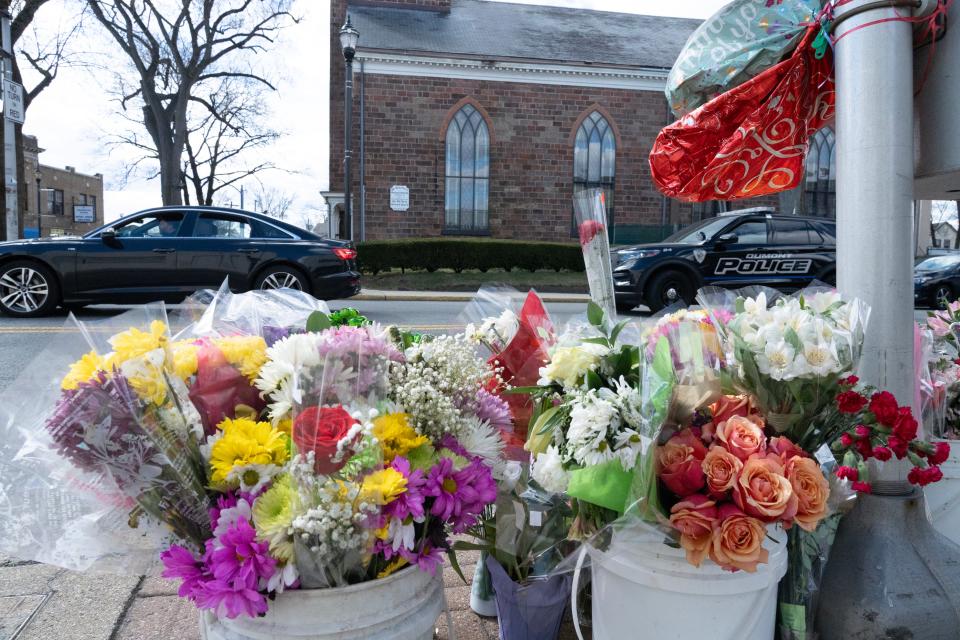Jun. 24—NORWICH — The Yantic River was well within its banks Monday, when about a dozen city leaders and regional planners toured eight locations where the river earlier this year flooded businesses and streets.
Severe flooding on Jan. 10 damaged shopping centers, the Yantic volunteer fire department, spots along West Town and Town streets and United Community and Family Services. The Yantic River and tributary streams frequently flood homes, businesses, streets and the Backus Hospital rear parking lot in Norwich. The river reached a near-record 14.2 feet on Jan. 10, nearly twice the level where residents and businesses are warned about potential flooding.
Yantic Fire Chief BJ Herz told the group during its first stop that the Jan. 10 flood reached the roof of the department’s picnic pavilion in the rear yard, called Firemen’s Field, which runs along the river. Herz said the fire station basement gets flood from rising groundwater. He said the department has taken some measures to secure a set of wooden stairs leading down to the picnic pavilion and has switched to sturdier metal picnic tables.
In past flooding, Herz said, firefighters would have to search downstream for the washed-out staircase.
The city is working with the Southeastern Connecticut Council of Governments and the Connecticut Institute for Resilience & Climate Action at the University of Connecticut to create a flood mitigation plan. Recommendations could include relocating some businesses in high-hazard flood areas, dredging portions of the Yantic where sediment has built up, improving drainage and better protecting buildings.
Deanna Rhodes, the city’s director of planning and neighborhood services, said city officials warn new businesses moving into flood-prone buildings of the hazards, but in many cases, they cannot stop them from leasing in those areas.
The group agreed the building at 20 New London Turnpike that houses Domino’s Pizza and Busy Bees children’s play center ― where boat rescues were required during the Jan. 10 flood ― would be a top priority for relocation. The river runs directly behind the building, and the low-lying parking lot frequently floods.
Asked for possible new locations, Rhodes pointed across Town Street, where three properties with vacant houses sitting on high ground had been approved for a Burger King restaurant. The Burger King plan has been abandoned, Mayor Peter Nystrom said.
Wayne Cableigh, vice president of client services for plan consultant GZA GeoEnvironmental, Inc., suggested if the 20 New London Turnpike building was demolished, the area could be made into a park that could absorb floodwaters at times.
Across New London Turnpike, the city did receive federal grant money in 2014 for a $760,000 plan to relocate the Nutmeg Companies from its flood-prone area on the riverbank.
Many of the businesses in the flood-prone areas do not have flood insurance, officials said. And some who do have flood insurance received no help after Jan. 10. Nystrom said a mattress business in a small mill on Clinton Avenue suffered damage and received no help from its flood insurance company.
Rhodes said she receives complaints frequently that the meadow created by demolishing Nutmeg is unsightly, but Long said the new natural area does allow for floodwater storage during storms. Rhodes suggested removing the remaining portion of asphalt driveway.
“I think it would make a difference in the appearance of this lot if people didn’t think it was a driveway to nowhere,” Rhodes said.
At the construction site of the new Sherman Street bridge, slated to open in August, city Engineer Brian Long pointed to sediment that has built up since the river was dredged following severe flooding in June of 1982. New dredging could increase the river’s capacity and reduce flooding, city officials said.
The new bridge is 18 inches higher than the old bridge, but on Jan. 10, water reached the bottom of the bridge. Long explained that severe flooding still could reach the bridge, but now, utility pipes are “tucked” beneath the bridge, where they are better protected than previously, when the pipes were suspended from the bridge and exposed to rushing water and debris.
The historic early-19th century Upper Falls dam is slowly collapsing into the river, one block at a time. The dam is constructed in two parts, half with a sloped earthen support and half with vertical stonework supporting the dam. During low-water flow times, water runs through an open gate at the bottom of the dam. During flooding, water rages over the entire length of the dam, spilling onto the riverbank.
Jones said the city has applied to the state for permission to remove the vertical portion of the dam.
“It is a constriction during flood events,” Long said. “When the water is flowing normally, like it is right now, it’s not going to be a whole lot different, with or without the dam. During flood events, the water is coming 2 feet over the top of this thing.”
The group ended the tour at the historic Uncas Leap falls, where the city is building a heritage park with walking trails, overlooks, picnic spots, a small amphitheater and restrooms.
Tour participants next will compile their information, including mapping of flood-prone areas, and a steering committee of municipal officials, planners, business, and Backus Hospital representatives will meet in the early fall. Helen Zincavage, director of regional planning for the council of governments, said the group will schedule a public informational meeting at that time.
Signup bonus from





